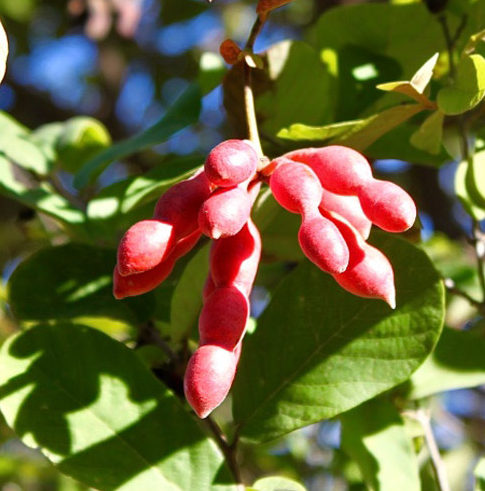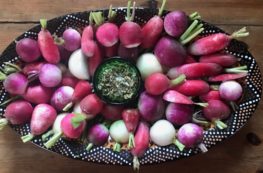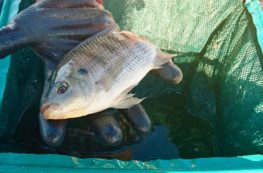Yomar Monsalve, my Michelin-starred new kitchen bestie, and I were back-and-forthing the other day about a dinner I was planning for his farewell from Livingstone, when he announced he’d bring along a “formula made from the magic sindambi for everyone to taste.” My Zambian assistant, Adelina Banda, later let on that sindambi was the Lozi word for rosella, the ubiquitous wild edible about which I wrote in July. So, no surprises there. I, on the other hand, was sure Yomar had never tasted the indigneous muchingachinga fruit, only because they weren’t in season. Back in May we’d juiced bucketfuls of the fruit, and frozen it to be used later in the year.
“Okay, Yomar,” I responded, “you bring your sindambi formula and I’ll give you my muchingachinga to sample, then we’ll compare. Deal?”
“Deal!”

Muchingachinga, or northern dwaba berries, or monkey fingers –“Don’t call them that,” Chris wails, “it’s an awful name!”– are indigenous fruit on a diminutive tree that thrives in semi-arid Kalahari sand throughout southern Africa. The tree is, in fact, from the custard apple family, the Annonaceae, but doesn’t look or taste like any one I’ve seen before. The custard apples I came across in America were a frumpy dull-green, covered in cellulite. A muchingachinga fruit, in comparison, is like one of those envied sirens: too many curves clothed in bombshell red.
With its sharp, almost-peppery taste and distinct scent, I guessed muchingachinga would make a perfect coulis. And how better to show off its bombshell red than to set it against the whitest of white dessert? I was considering vanilla ice cream until Chris’s sister, Dee, wrote to me about a sublime (green tea) panna cotta she’d just eaten in a restaurant in her home city of Melbourne in Australia. She induced a light-bulb moment: I’d serve the bombshell-red coulis with a virgin-white coconut panna cotta.

Coconut Panna Cotta with Muchingachinga Coulis
Yield: 12 servings
Ingredients:
Coconut Panna Cotta
- 9 gelatin leaves, or 4 level tablespoons gelatin granules
- 1 tablespoon coconut oil
- 3 400ml-tins coconut milk
- 2 cups/450mls full milk
- 1/2 cup caster sugar
Muchingachinga Coulis
- 2 cups muchingachinga pulp/ juice
- 1/4 cup caster sugar
- Juice of half a lemon
Method:
1. Soak the gelatin leaves in cold water for at least five minutes, or if using gelatin granules follow the product’s instructions because different brands can vary greatly.
2. Grease the insides of 12 ramekins with coconut oil.
3. Combine the coconut milk, milk, and sugar in a saucepan and bring to the boil, stirring regularly to dissolve the sugar. As soon as the mixture starts to bubble, remove from the heat.
4. Lift the softened gelatin out of the water and add to the milk mixture, ensuring it dissolves completely.
5. Pour the mixture into individual ramekins or small cups, cool, and then refrigerate until set, at least 3-4 hours. (I left mine overnight because of our challenged refrigeration capabilities in this intense heat.)
6. In a heavy-based saucepan bring the muchingachinga, sugar, and lemon juice to the boil, stirring regularly to dissolve the sugar. Turn down the heat and simmer the mixture until it reduces by half to three-quarters, depending on how thick you like it. Set aside and cool. (Please note that it’s often necessary to strain certain types of cooked fruit before setting aside to cool, although I didn’t need to this time.)
7. When ready to serve, turn the panna cotta ramekins out onto individual plates. (Running a small sharp knife around the edge of the ramekin will help to plop it out.) Garnish with the muchingachinga coulis.
Footnote: When Yomar tasted the muchingachinga coulis his face lit up. “I’ve never tasted anything like it!” he beamed. (And let me tell you, he’s tasted stuff I wouldn’t dream of allowing past my lips.) “Wow! It is so, so zingy. It reminds me of the first time I licked a battery … you know, it has that special sizzle!” No. I don’t. And I have no intention of finding out, ahem.
Footnote II: The magic sindambi, now officially named Magic Zindambi — to honor the life-giving Zambezi River — was an equal hit with Chris and me. Yomar’s formula turned out to be an intense syrup, crafted out of the flowers, leaves and stems of the indigenous rosella plant, diluted in sparkling water. Cheers!






15 Comments
Annabel! Your blogs are such a pleasure to read – and the blend of Africa is magic for us far away bush souls.
And you’ve inspired me for tonight’s dinner party but the coulis will have to be something tame like raspberries…
Keep on blogging 🙂
Thank you for your sweet comment, Dee. Please let me know how your dinner turned out. Being the other side of the world I am wondering if you are sitting down to eat now?
Hi Annabel. Home in Sydney now. Reading your blog with the beautiful photos, recipes & stories is like reading a good book. I think you could create a lovely cook book that is different from all the others.
Kathy x
Hello dear Kathy … welcome home and thank you. What an inspiring comment to wake up to. It makes me so happy to picture you, all the way over in Sydney, enjoying my blog. People like you make blogging such a rewarding pastime … xo
Love it – am going to introduce your blog to “travelling hungry girl” based here in Naples!!
Oh wow! Thank you, Georgie … how kind! I’m wondering if Travelling Hungry Girl travels all around the world, or just around your neck of the woods?
I can’t believe you’ve never licked a battery! It’s a perfect description… you must try it for the sake of having it in your library of sensations. Nine volt works best. ; ) Lovely photos, lovely ideas, lovely words…
Thank you for your kind comment, Anna. I think I’ll stick to the muchingachinga for now … and if by chance they don’t bear fruit next year then maybe I’ll venture into the workshop. 😉
I believe I just read the finest and funniest line of the week in the worldwide blogosphere….. “A muchingachinga fruit, in comparison, is like one of those envied sirens: too many curves clothed in bombshell red.” Be careful, Annabel, you might become rich and famous writing with such style. Bravo!
And now, as the sun sets, I’ve just read one the loveliest compliments yet, all the way from Indiana in the great USofA. Thank you, Jim. You’ve made my day … as have the raindrops that arrived at the same time as your comment. The wet season is upon us. At last! (We only have two seasons: dry and wet.)
[…] eggs and a little sugar, how can we not make it? In this instance I added a marbling of muchingachinga syrup which, with its zingy tartness, added a wild je ne sais quoi to the creamy vanilla ice […]
[…] forage from the wild are also much loved by elephants: mongongo nuts, marulas, wildsour plums, and muchingachinga fruit. I’ll be developing more and more recipes with these wild edibles as we move along. […]
[…] I wrote in a previous post, “The [Muchingachinga] tree is, in fact, from the custard apple family, the Annonaceae, but […]
Great piece of work Annabel. Am impressed with your creativity and I feel energized by your work to up with African recipes especially the ones with world fruit ingredients.
Keep the fire burning Annabel.
Michael Munali
Thank you so much for your interest!
Comments are closed.